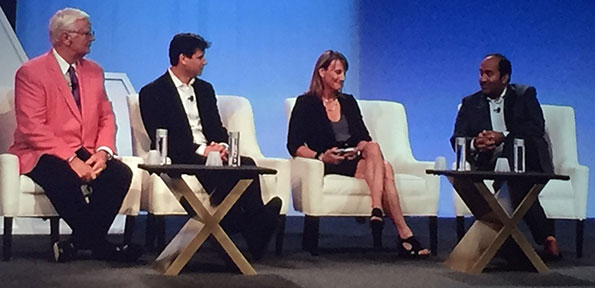Speakers at the FMI Midwinter Executive Conference in Miami wrapped up the event by taking stands on where trends are headed, from consumer shifts to digital directions.
Industry executives were given a crash course in assessing the future by a bona fide futurist, Sheryl Connelly, a global consumer trends expert who is one of Fast Company’s “Most Creative People in Business.”
“Beware of the SWOT analysis,” she warned the Midwinter audience. “SWOT is glorified naval gazing and too insular. You’ll be blindsided by non-traditional competitors.”
She instead advised executives to think provocatively about the path of events and challenge the status quo. “But also be plausible and don’t chase fads,” she said. “Challenge the status quo by imagining multiple futures. That way you don’t need to really know the future, as long as you have a solid plan.”
Connelly urged a proactive stance from leaders, saying, “The best way to predict the future is to create it. Individuals and companies can create the future, so have meaningful conversations on what the future will look like.”
 Monday’s panelists were (from left) Thom Blischok, Scott Moses, Suzy Monford and moderator Rohit Bhargava.
Monday’s panelists were (from left) Thom Blischok, Scott Moses, Suzy Monford and moderator Rohit Bhargava.In a follow-up panel, industry executives addressed the future of the marketplace, from stores to shoppers. Following are some of the key points:
• Battle with restaurants: Food retailers have new opportunities in their battle for share of stomach with restaurants, said Thom Blischok, chief retail strategist, PwC. “If there’s one trip that’s going to shift this year at retail, it will be the restaurant trip,” he said. “This afternoon at 4 p.m., 70% of America doesn’t know what it’s having for dinner. Retailers need to create the experience of restaurant-quality food, and offer the ability to order it online, and pick it up in the store.”
Another panelist emphasizing this point was Scott Moses, managing director and head of food, drug and specialty retail investment banking at Sagent Advisors. “Over the last two or three years, much of the share of stomach gains the food retail sector had generated has been ceded back to restaurants,” he said. “So it’s important to make the grocery store a destination where people go when figuring out what to have for dinner.”
• Omnichannel: “You need to make omnichannel feel local to the consumer, and you need to make it part of the experience of what you’re doing in the stores,” said Blischok. “You have to make the smartphone integrate with what’s in-store and online.”
• Store resurgence: Despite growing focus on digital and e-commerce, “The store is alive and well,” Blischok said. “Retailers are more focused on the perimeter. People realize it’s fun to shop again. This is about local, experiential and a bit of a return to the store for a different kind of experience.”
• Clicks vs. bricks: Asked when click sales will surpass brick sales in food retail, Blischok replied, “It won’t. Grocery will top out at about 10%-15% online.”
 Suzy Monford, CEO, Andronico’s
Suzy Monford, CEO, Andronico’sPanelist Suzy Monford, CEO, Andronico’s Community Markets, said, “Brick and mortar is here to stay, but there are too many stores in the marketplace. There will be many fewer as we get smarter and as stores become more hub and spoke.”
• Big vs. small stores: Blischok said the industry shouldn’t exclusively focus on the debate over size. “It’s about how relevant can you get,” he asserted, “and the ability to serve the community in the sights you have.”
Monford said retailers need to factor day-parting into the equation when selecting store sizes. “You need to understand the traffic flow,” she said. “How much traffic do you have at different times? It’s not just about total population in a market but also about day-parting.”
The panel moderator was Rohit Bhargava, founder of the Influential Marketing Group, author and a professor of marketing at Georgetown University.
| Suggested Categories | More from Supermarket News |
 |
|
 |
|





